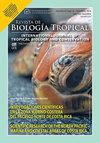Reserve mobilization and secondary metabolites during seed germination and seedling establishment of the tree Erythrina velutina (Fabaceae)
IF 0.6
4区 生物学
Q4 BIOLOGY
引用次数: 0
Abstract
Introduction: The lack of knowledge on seed germination and seedling establishment is a main constraint for the restoration of degraded areas, including the tropical dry forest known as Caatinga. Objective: To assess reserve and secondary metabolite mobilization during seed germination and seedling establishment in Erythina velutina. Methods: We scarified, disinfected, imbibed, sown between towel paper, and incubated seeds under controlled conditions. We hydroponically cultivated seedlings in a greenhouse. We harvested cotyledons at seed imbibition, radicle protrusion, hypocotyl emergence, apical hook formation and expansion of cordiform leaves, first trifoliate leaf, and second trifoliate leaf. Results: Seeds contained approximately 20 % starch, 14.5 storage proteins, 11.6 neutral lipids, and 5.7 % non-reducing sugars on a dry weight basis. Soluble sugars were mainly consumed from hypocotyl emergence to apical hook formation, while major reserves were mobilized from apical hook formation to expansion of first trifoliate leaf. Enzymatic activity increased from mid to late seedling establishment, causing the mobilization of starch, oils, and proteins. Terpenoid-derivatives, flavonoids, phenolic acids, and alkaloids were detected. Flavonoids and phenolic acids were present at almost all stages and terpenoid-derivatives disappeared at expansion of cordiform leaves. Conclusion: Soluble sugars support early seedling growth, while starch, oils and proteins are simultaneously mobilized from mid to late establishment by amylases, lipases, and acid proteases. The cotyledons contain secondary metabolites, which may act in seedling defense. High content of reserves and presence of secondary metabolites in the cotyledons could enable E. velutina seedlings endure stress, validating their use in the restoration of degraded areas.蚕豆科赤藓种子萌发和成苗过程中的储备动员和次生代谢产物
缺乏关于种子萌发和幼苗建立的知识是退化地区恢复的主要制约因素,包括被称为Caatinga的热带干燥林。目的:评价黄皮草种子萌发和成苗过程中储备和次生代谢物的动员。方法:在一定条件下,对棉籽进行消毒、消毒、吸药、纸巾间播种和培养。我们在温室里水培秧苗。在种子吸胀、胚根突出、下胚轴出苗、顶钩形成和堇形叶、第一三叶和第二三叶展开时收获子叶。结果:在干重基础上,种子含有大约20%的淀粉,14.5%的储存蛋白,11.6%的中性脂和5.7%的非还原糖。可溶性糖主要从下胚轴萌发到顶钩形成阶段消耗,而主要储备则从顶钩形成到第一三叶膨大阶段调动。从幼苗建立中期到后期,酶活性增加,导致淀粉、油脂和蛋白质的动员。萜类衍生物、类黄酮、酚酸和生物碱均被检测到。黄酮类和酚酸类几乎在所有阶段都存在,萜类衍生物在堇状叶膨大时消失。结论:可溶性糖支持幼苗早期生长,淀粉酶、脂肪酶和酸性蛋白酶同时动员淀粉、油脂和蛋白质。子叶含有次生代谢物,可能具有保护幼苗的作用。子叶中含有丰富的次生代谢物和储备,可以使黄叶青幼苗抵御胁迫,从而验证了其在退化地区恢复中的应用。
本文章由计算机程序翻译,如有差异,请以英文原文为准。
求助全文
约1分钟内获得全文
求助全文
来源期刊

Revista De Biologia Tropical
生物-生物学
CiteScore
1.80
自引率
0.00%
发文量
23
审稿时长
4-8 weeks
期刊介绍:
The Revista de Biología Tropical / International Journal of Tropical Biology and Conservation is a mainstream scientific journal published since 1953 and covered by Web of Science; Science Citation Index; Current Contents; Google Scholar; Scopus, SciELO and nearly 50 additional indices.
A double blind system guarantees you a fair evaluation, and our world class editorial and scientific boards provides a first decision in three working days. The journal is Full Open Access and is widely read where your article can have the highest real impact.
Since its beginning in 1953, the Revista follows these principles: objective and independent evaluation of all manuscripts; transparency in all processes; ethical use of procedures, data, specimens and subjects; fair treatment of all parties; and absolute predominance of scientific rigor over any other aspect.
 求助内容:
求助内容: 应助结果提醒方式:
应助结果提醒方式:


